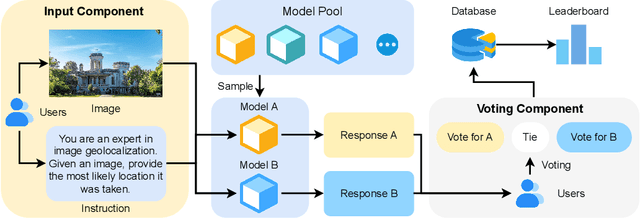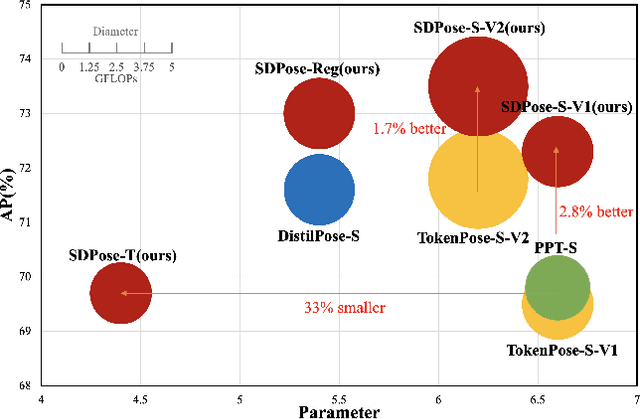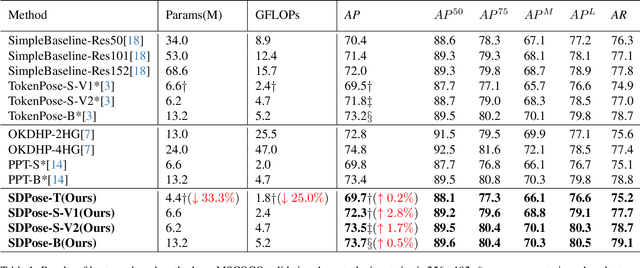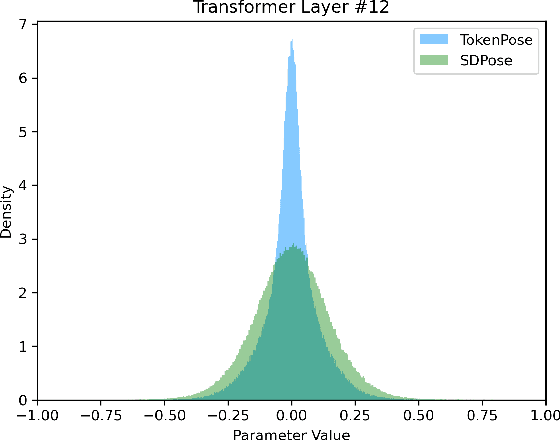Yingyi Zhang
Causality-aware Graph Aggregation Weight Estimator for Popularity Debiasing in Top-K Recommendation
Oct 06, 2025Abstract:Graph-based recommender systems leverage neighborhood aggregation to generate node representations, which is highly sensitive to popularity bias, resulting in an echo effect during information propagation. Existing graph-based debiasing solutions refine the aggregation process with attempts such as edge reconstruction or weight adjustment. However, these methods remain inadequate in fully alleviating popularity bias. Specifically, this is because 1) they provide no insights into graph aggregation rationality, thus lacking an optimality guarantee; 2) they fail to well balance the training and debiasing process, which undermines the effectiveness. In this paper, we propose a novel approach to mitigate popularity bias through rational modeling of the graph aggregation process. We reveal that graph aggregation is a special form of backdoor adjustment in causal inference, where the aggregation weight corresponds to the historical interaction likelihood distribution. Based on this insight, we devise an encoder-decoder architecture, namely Causality-aware Graph Aggregation Weight Estimator for Debiasing (CAGED), to approximate the unbiased aggregation weight by optimizing the evidence lower bound of the interaction likelihood. In order to enhance the debiasing effectiveness during early training stages, we further design a momentum update strategy that incrementally refines the aggregation weight matrix. Extensive experiments on three datasets demonstrate that CAGED outperforms existing graph-based debiasing methods. Our implementation is available at https://github.com/QueYork/CAGED.
SciNLP: A Domain-Specific Benchmark for Full-Text Scientific Entity and Relation Extraction in NLP
Sep 10, 2025Abstract:Structured information extraction from scientific literature is crucial for capturing core concepts and emerging trends in specialized fields. While existing datasets aid model development, most focus on specific publication sections due to domain complexity and the high cost of annotating scientific texts. To address this limitation, we introduce SciNLP - a specialized benchmark for full-text entity and relation extraction in the Natural Language Processing (NLP) domain. The dataset comprises 60 manually annotated full-text NLP publications, covering 7,072 entities and 1,826 relations. Compared to existing research, SciNLP is the first dataset providing full-text annotations of entities and their relationships in the NLP domain. To validate the effectiveness of SciNLP, we conducted comparative experiments with similar datasets and evaluated the performance of state-of-the-art supervised models on this dataset. Results reveal varying extraction capabilities of existing models across academic texts of different lengths. Cross-comparisons with existing datasets show that SciNLP achieves significant performance improvements on certain baseline models. Using models trained on SciNLP, we implemented automatic construction of a fine-grained knowledge graph for the NLP domain. Our KG has an average node degree of 3.2 per entity, indicating rich semantic topological information that enhances downstream applications. The dataset is publicly available at https://github.com/AKADDC/SciNLP.
GeoArena: An Open Platform for Benchmarking Large Vision-language Models on WorldWide Image Geolocalization
Sep 04, 2025



Abstract:Image geolocalization aims to predict the geographic location of images captured anywhere on Earth, but its global nature presents significant challenges. Current evaluation methodologies suffer from two major limitations. First, data leakage: advanced approaches often rely on large vision-language models (LVLMs) to predict image locations, yet these models are frequently pretrained on the test datasets, compromising the accuracy of evaluating a model's actual geolocalization capability. Second, existing metrics primarily rely on exact geographic coordinates to assess predictions, which not only neglects the reasoning process but also raises privacy concerns when user-level location data is required. To address these issues, we propose GeoArena, a first open platform for evaluating LVLMs on worldwide image geolocalization tasks, offering true in-the-wild and human-centered benchmarking. GeoArena enables users to upload in-the-wild images for a more diverse evaluation corpus, and it leverages pairwise human judgments to determine which model output better aligns with human expectations. Our platform has been deployed online for two months, during which we collected over thousands voting records. Based on this data, we conduct a detailed analysis and establish a leaderboard of different LVLMs on the image geolocalization task.
Towards Multi-Granularity Memory Association and Selection for Long-Term Conversational Agents
May 26, 2025Abstract:Large Language Models (LLMs) have recently been widely adopted in conversational agents. However, the increasingly long interactions between users and agents accumulate extensive dialogue records, making it difficult for LLMs with limited context windows to maintain a coherent long-term dialogue memory and deliver personalized responses. While retrieval-augmented memory systems have emerged to address this issue, existing methods often depend on single-granularity memory segmentation and retrieval. This approach falls short in capturing deep memory connections, leading to partial retrieval of useful information or substantial noise, resulting in suboptimal performance. To tackle these limits, we propose MemGAS, a framework that enhances memory consolidation by constructing multi-granularity association, adaptive selection, and retrieval. MemGAS is based on multi-granularity memory units and employs Gaussian Mixture Models to cluster and associate new memories with historical ones. An entropy-based router adaptively selects optimal granularity by evaluating query relevance distributions and balancing information completeness and noise. Retrieved memories are further refined via LLM-based filtering. Experiments on four long-term memory benchmarks demonstrate that MemGAS outperforms state-of-the-art methods on both question answer and retrieval tasks, achieving superior performance across different query types and top-K settings.
Align-GRAG: Reasoning-Guided Dual Alignment for Graph Retrieval-Augmented Generation
May 22, 2025Abstract:Large language models (LLMs) have demonstrated remarkable capabilities, but still struggle with issues like hallucinations and outdated information. Retrieval-augmented generation (RAG) addresses these issues by grounding LLM outputs in external knowledge with an Information Retrieval (IR) system. Building on this foundation, graph-based RAG systems go a step further by retrieving subgraphs, which preserve the relationships between knowledge entities and provide more comprehensive context. However, graph RAG faces two challenges: (1) Retrieving relevant information introduces irrelevant nodes (especially in dense graph databases, where retrieval usually extends to adjacent nodes), and leads to overly lengthy inputs that hinder efficiency; (2) The representation gap between graph and language during generation with LLMs limits the ability to fully leverage graph structures for enhanced understanding. To address these limitations, we propose Align-GRAG, a novel reasoning-guided dual alignment framework in post-retrieval phrase. It first formulates a subgraph by retrieving nodes and edges. Then an Aligner is proposed to jointly optimizes a graph encoder with LLM-summarized reasoning. It achieves dual alignment of graph node and representation by leveraging KL divergence loss and contrastive loss, facilitating efficient pruning of irrelevant knowledge and establishing a unified semantic space. The Generator integrates the aligned graph data with LLM to produce coherent and accurate answers. Experiments on GraphQA benchmark across three tasks (including common sense reasoning, scene graph understanding, and knowledge graph reasoning) validate the effectiveness of our method. The code will be available upon accepted.
Process vs. Outcome Reward: Which is Better for Agentic RAG Reinforcement Learning
May 20, 2025Abstract:Retrieval-augmented generation (RAG) enhances the text generation capabilities of large language models (LLMs) by integrating external knowledge and up-to-date information. However, traditional RAG systems are limited by static workflows and lack the adaptability required for multistep reasoning and complex task management. To address these limitations, agentic RAG systems (e.g., DeepResearch) have been proposed, enabling dynamic retrieval strategies, iterative context refinement, and adaptive workflows for handling complex search queries beyond the capabilities of conventional RAG. Recent advances, such as Search-R1, have demonstrated promising gains using outcome-based reinforcement learning, where the correctness of the final answer serves as the reward signal. Nevertheless, such outcome-supervised agentic RAG methods face challenges including low exploration efficiency, gradient conflict, and sparse reward signals. To overcome these challenges, we propose to utilize fine-grained, process-level rewards to improve training stability, reduce computational costs, and enhance efficiency. Specifically, we introduce a novel method ReasonRAG that automatically constructs RAG-ProGuide, a high-quality dataset providing process-level rewards for (i) query generation, (ii) evidence extraction, and (iii) answer generation, thereby enhancing model inherent capabilities via process-supervised reinforcement learning. With the process-level policy optimization, the proposed framework empowers LLMs to autonomously invoke search, generate queries, extract relevant evidence, and produce final answers. Compared to existing approaches such as Search-R1 and traditional RAG systems, ReasonRAG, leveraging RAG-ProGuide, achieves superior performance on five benchmark datasets using only 5k training instances, significantly fewer than the 90k training instances required by Search-R1.
LSRP: A Leader-Subordinate Retrieval Framework for Privacy-Preserving Cloud-Device Collaboration
May 08, 2025Abstract:Cloud-device collaboration leverages on-cloud Large Language Models (LLMs) for handling public user queries and on-device Small Language Models (SLMs) for processing private user data, collectively forming a powerful and privacy-preserving solution. However, existing approaches often fail to fully leverage the scalable problem-solving capabilities of on-cloud LLMs while underutilizing the advantage of on-device SLMs in accessing and processing personalized data. This leads to two interconnected issues: 1) Limited utilization of the problem-solving capabilities of on-cloud LLMs, which fail to align with personalized user-task needs, and 2) Inadequate integration of user data into on-device SLM responses, resulting in mismatches in contextual user information. In this paper, we propose a Leader-Subordinate Retrieval framework for Privacy-preserving cloud-device collaboration (LSRP), a novel solution that bridges these gaps by: 1) enhancing on-cloud LLM guidance to on-device SLM through a dynamic selection of task-specific leader strategies named as user-to-user retrieval-augmented generation (U-U-RAG), and 2) integrating the data advantages of on-device SLMs through small model feedback Direct Preference Optimization (SMFB-DPO) for aligning the on-cloud LLM with the on-device SLM. Experiments on two datasets demonstrate that LSRP consistently outperforms state-of-the-art baselines, significantly improving question-answer relevance and personalization, while preserving user privacy through efficient on-device retrieval. Our code is available at: https://github.com/Zhang-Yingyi/LSRP.
A Survey of Personalization: From RAG to Agent
Apr 14, 2025Abstract:Personalization has become an essential capability in modern AI systems, enabling customized interactions that align with individual user preferences, contexts, and goals. Recent research has increasingly concentrated on Retrieval-Augmented Generation (RAG) frameworks and their evolution into more advanced agent-based architectures within personalized settings to enhance user satisfaction. Building on this foundation, this survey systematically examines personalization across the three core stages of RAG: pre-retrieval, retrieval, and generation. Beyond RAG, we further extend its capabilities into the realm of Personalized LLM-based Agents, which enhance traditional RAG systems with agentic functionalities, including user understanding, personalized planning and execution, and dynamic generation. For both personalization in RAG and agent-based personalization, we provide formal definitions, conduct a comprehensive review of recent literature, and summarize key datasets and evaluation metrics. Additionally, we discuss fundamental challenges, limitations, and promising research directions in this evolving field. Relevant papers and resources are continuously updated at https://github.com/Applied-Machine-Learning-Lab/Awesome-Personalized-RAG-Agent.
SDPose: Tokenized Pose Estimation via Circulation-Guide Self-Distillation
Apr 04, 2024



Abstract:Recently, transformer-based methods have achieved state-of-the-art prediction quality on human pose estimation(HPE). Nonetheless, most of these top-performing transformer-based models are too computation-consuming and storage-demanding to deploy on edge computing platforms. Those transformer-based models that require fewer resources are prone to under-fitting due to their smaller scale and thus perform notably worse than their larger counterparts. Given this conundrum, we introduce SDPose, a new self-distillation method for improving the performance of small transformer-based models. To mitigate the problem of under-fitting, we design a transformer module named Multi-Cycled Transformer(MCT) based on multiple-cycled forwards to more fully exploit the potential of small model parameters. Further, in order to prevent the additional inference compute-consuming brought by MCT, we introduce a self-distillation scheme, extracting the knowledge from the MCT module to a naive forward model. Specifically, on the MSCOCO validation dataset, SDPose-T obtains 69.7% mAP with 4.4M parameters and 1.8 GFLOPs. Furthermore, SDPose-S-V2 obtains 73.5% mAP on the MSCOCO validation dataset with 6.2M parameters and 4.7 GFLOPs, achieving a new state-of-the-art among predominant tiny neural network methods. Our code is available at https://github.com/MartyrPenink/SDPose.
RPG-Palm: Realistic Pseudo-data Generation for Palmprint Recognition
Aug 08, 2023



Abstract:Palmprint recently shows great potential in recognition applications as it is a privacy-friendly and stable biometric. However, the lack of large-scale public palmprint datasets limits further research and development of palmprint recognition. In this paper, we propose a novel realistic pseudo-palmprint generation (RPG) model to synthesize palmprints with massive identities. We first introduce a conditional modulation generator to improve the intra-class diversity. Then an identity-aware loss is proposed to ensure identity consistency against unpaired training. We further improve the B\'ezier palm creases generation strategy to guarantee identity independence. Extensive experimental results demonstrate that synthetic pretraining significantly boosts the recognition model performance. For example, our model improves the state-of-the-art B\'ezierPalm by more than $5\%$ and $14\%$ in terms of TAR@FAR=1e-6 under the $1:1$ and $1:3$ Open-set protocol. When accessing only $10\%$ of the real training data, our method still outperforms ArcFace with $100\%$ real training data, indicating that we are closer to real-data-free palmprint recognition.
 Add to Chrome
Add to Chrome Add to Firefox
Add to Firefox Add to Edge
Add to Edge